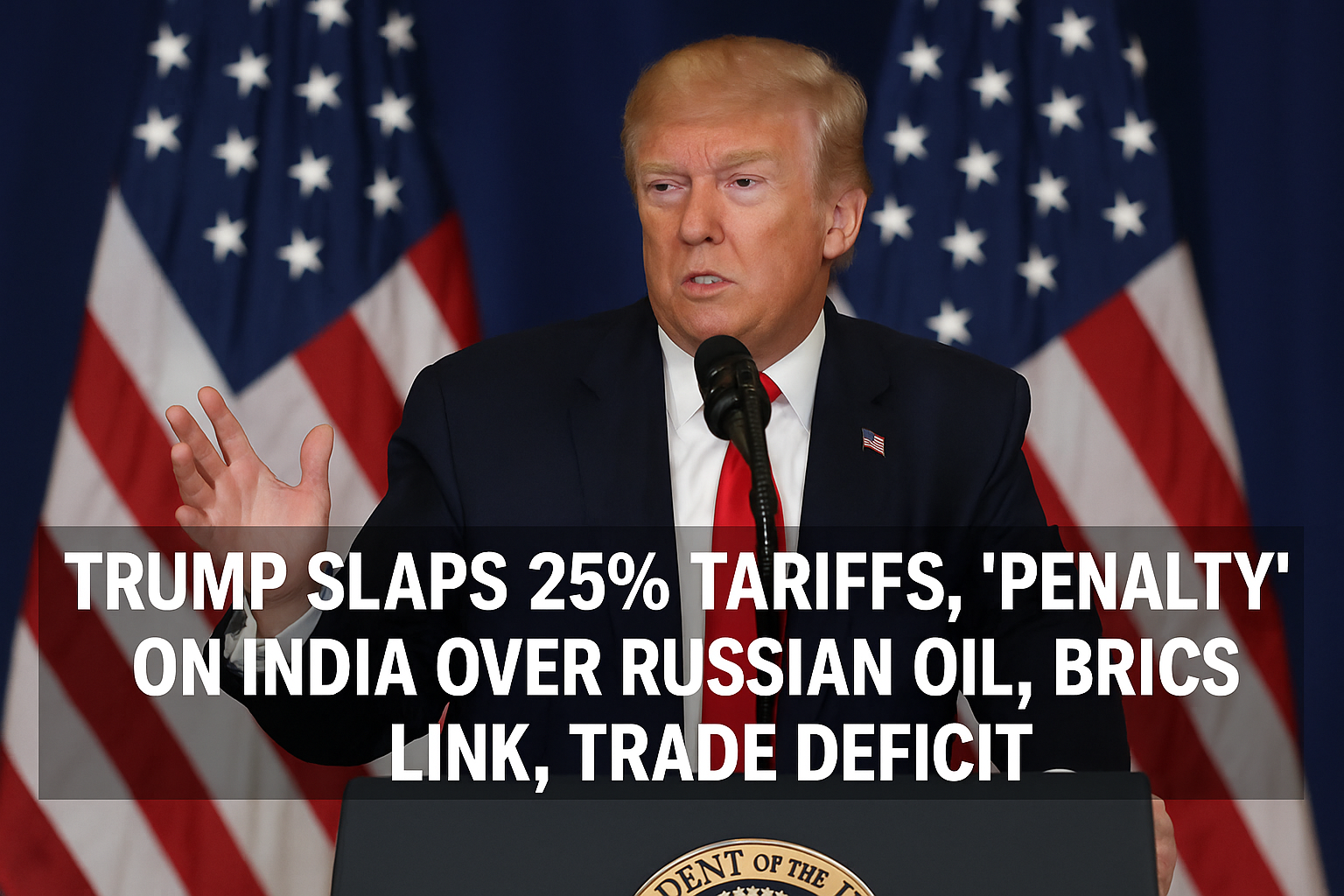In a major escalation that could reshape global trade dynamics, former U.S. President Donald Trump has announced a 25% tariff on all Indian imports, along with an additional “penalty” tied to India’s energy trade with Russia and its growing alignment with BRICS. The move, announced on July 30, 2025, is already sending shockwaves across markets, diplomacy tables, and the policy corridors of Delhi.
Let’s unpack what happened, why it matters, and how it could affect you.
📣 What Did Trump Say?
From his campaign headquarters, Trump declared:
“India is profiting off America while doing massive business with Russia. That stops now. A 25% tariff begins August 1st — and a penalty too. This is about fairness, energy, and American jobs.”
The surprise statement immediately triggered diplomatic buzz and market volatility, especially considering India’s $87 billion exports to the U.S. in 2024.
🧾 Why Is This Happening?
Trump cited three main reasons behind the tariff and penalty:
1. Massive Trade Deficit
The U.S. had a $45.7 billion trade deficit with India in 2024. Trump, known for his “America First” policies, considers this imbalance unacceptable.
2. India–Russia Oil Ties
India continues to purchase discounted crude oil and defense equipment from Russia, despite global pressure over Moscow’s invasion of Ukraine. Trump claims this “funds Putin’s war.”
3. BRICS Alignment
India’s deepening involvement in BRICS — a coalition of emerging economies (Brazil, Russia, India, China, South Africa) — is viewed by Trump as a threat to the U.S. dollar’s dominance and global trade order.
🛑 The “Penalty” Explained
In addition to the tariffs, Trump mentioned an unspecified penalty. Analysts believe this could be:
- Export restrictions on critical technologies
- Financial sanctions on Indian entities dealing with Russia
- Visa policy tightening for Indian professionals
- Blocking access to U.S. defense tech
📦 Which Indian Sectors Are Most at Risk?
The U.S. is one of India’s largest trading partners. Key sectors that could take a direct hit:
| Sector | Risk Level |
|---|---|
| Pharmaceuticals | 🔴 High |
| Textiles | 🟠 Medium |
| Electronics | 🔴 High |
| Auto Components | 🟠 Medium |
| Gems & Jewelry | 🔴 High |
| Refined Petroleum | 🔴 High |
For businesses relying heavily on U.S. exports, costs could skyrocket, profit margins could shrink, and supply chains may get disrupted.
🧠 Is There Still Hope for a Deal?
Yes — negotiations are ongoing.
U.S. Trade Representative Katherine Tai has indicated that “Washington is open to resolving differences through bilateral discussions.” Indian officials are also exploring options, hoping to find a middle ground by early August.
India may propose:
- A new trade balancing framework
- Commitment to reduce imports from Russia gradually
- Support for U.S.-led energy initiatives in the Indo-Pacific
🔋 The Surprise Twist: Trump’s Pakistan Oil Pitch
Perhaps the most unexpected announcement: Trump revealed a new U.S.–Pakistan oil partnership.
“We’ll help Pakistan develop massive energy reserves. Maybe they’ll be selling oil to India soon.”
This statement, loaded with both strategic pressure and geopolitical posturing, hints at Trump’s larger aim to redraw the energy map of South Asia.
📉 What Does It Mean for India?
Short-Term:
- Exporters may face declining demand from U.S. buyers
- Volatility in currency and equity markets
- Possible slowdown in trade-led GDP growth
Medium-Term:
- Push for diversifying export markets (EU, ASEAN, Africa)
- Incentivizing domestic consumption and import substitution
- Tighter ties with Russia, Iran, UAE in energy corridors
🌐 What It Means for the World
- BRICS nations may close ranks and accelerate de-dollarization
- Trade wars could return, reminiscent of Trump’s first term tariffs (2018–2020)
- The global south may grow more assertive, especially with India caught between two superpowers
Thoughts
Trump’s tariff-and-penalty combo isn’t just a trade story — it’s a power play. It highlights the fragile balance of diplomacy, trade, energy, and ideology in today’s multipolar world.
For India, it’s a test of its diplomatic finesse and economic resilience.
For the U.S., it’s a high-stakes gamble to reassert dominance.
And for the world — it may just be the opening chapter of a new cold trade war.


Leave a Reply